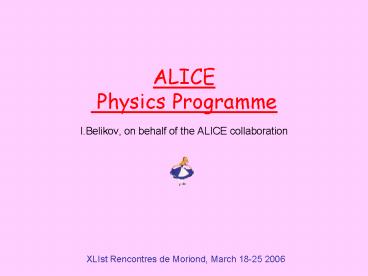ALICE Physics Programme - PowerPoint PPT Presentation
1 / 11
Title:
ALICE Physics Programme
Description:
In medium energy loss of the heavy quarks. Dissociation/regeneration of the quarkonia states in QGP. Hight Pt QGP probes. Jet quenching ... – PowerPoint PPT presentation
Number of Views:41
Avg rating:3.0/5.0
Title: ALICE Physics Programme
1
ALICE Physics Programme
- I.Belikov, on behalf of the ALICE collaboration
2
Outline
- ALICE experiment at CERN.
- The primary goal
- ALICE detector
- Soft QGP probes.
- Global event properties
- Properties of resonances
- Heavy flavour QGP probes.
- In medium energy loss of the heavy quarks.
- Dissociation/regeneration of the quarkonia states
in QGP. - Hight Pt QGP probes.
- Jet quenching
- Jet-structure observables
- Conclusions.
3
The primary goal
A Large Ion Collider Experiment is a
general-purpose heavy-ion experiment designed to
study the physics of strongly interacting matter
and the quark-gluon plasma in nucleus-nucleus
collisions at the LHC
4
ALICE detector
TPC (-0.9lthlt0.9) tracking efficiency 80 for
Ptlt0.2 GeV/c (limited by decays) 90 for Ptgt1
GeV/c (limited by dead zones) Up to 20000 tracks
in the TPC ! Momentum resolution (0.5 T) 1
at Pt1 GeV/c 4 at Pt100 GeV/c Excellent
charged PID capability from P0.1 GeV/c upto a
few GeV/c (upto a few tens GeV/c, TPC rel. rise)
electrons in TRD, Pgt1GeV/c Capability of neutral
PID as well. Precise (better than 100
mm) vertexing
5
Soft QGP probes Global event properties in Pb-Pb
Silicon Pixel Detector (SPD) -1.6 lt h lt
1.6 Forward Multiplicity Detector (FMD) h
-5, 3.5
dN/dh vs centrality (Npart) Fraction of
particles produced in hard processes
Generated Tracklets
1 central Hijing event
6
Soft QGP probes Properties of resonances (r, f,
K, )
Time difference between chemical and kinetic
freeze-out in medium modifications of mass,
width, hadronic and leptonic channels partial
chiral symmetry restoration
r0(770) pp- 106 central Pb-Pb
K(892)0 K p 15000 central Pb-Pb
Mass resolution 2-3 MeV
Invariant mass (GeV/c2)
Generated reconstructed f for 107 central Pb-Pb
Mass resolution 1.2 MeV
f (1020) KK-
7
Heavy flavour QGP probesEnergy loss physics
Dead cone effect. Mass dependence of energy loss.
Charm
8
Heavy flavour QGP probesDissociation/regeneratio
n of quarkonia
SPS
RHIC
LHC
J/Y regeneration
H. Satz, CERN Heavy Ion Forum, 09/06/05
J/Y melting
- Melting of Y and c at SPS and RHIC, and melting
of J/Y at LHC ? - Magic cancellation between J/Y suppression and
J/Y regeneration ? - First measurements of bottomonia at LHC.
- Regeneration is expected to be small.
9
High Pt QGP probesJet quenching
Evidence for partonic energy loss in heavy ion
collisions
PRL91, 072304 (2003)
1/NtriggerdN/d(??)
gluon radiation
High-pT hadrons of recoiling jet suppressed in
AuAu but not in dAu
(Almost) full jet reconstruction in ALICE
10
High Pt QGP probesJet-structure observables
Jet particle momentum perpendicular to jet axis
(kt)
Salgado, Wiedemann, hep-ph/0310079
- In ALICE
- Particles in the jet down to 1 GeV/c.
- Jets with PID (dead cone structures).
11
Conclusions
- ALICE experiment at LHC is aiming to study the
physics of strongly interacting matter at extreme
energy densities, where a new state of matter,
quark-gluon plasma, is expected to be reached. - Due to its excellent track and vertex finding and
particle identification capabilities, ALICE will
be able to study the properties of QGP by means
of a whole set of different and independent
observables.

